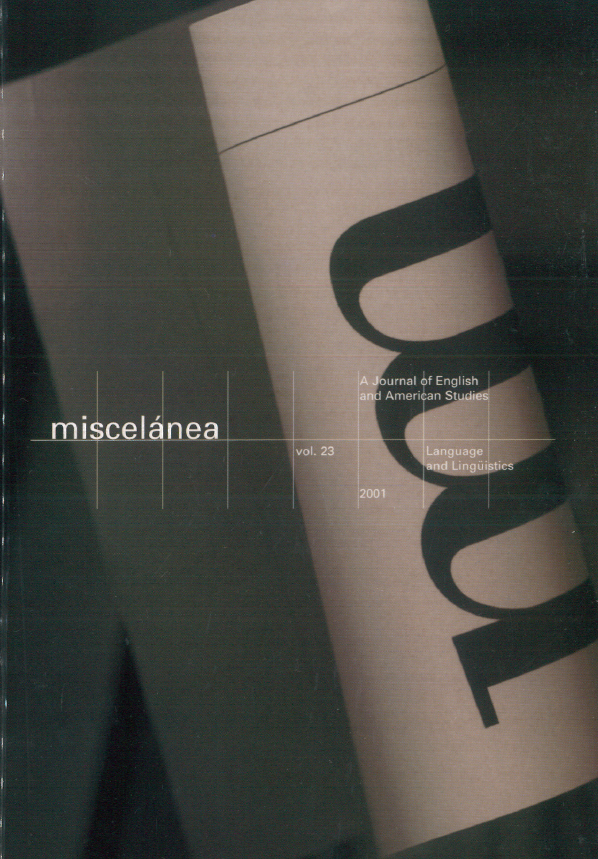Progresión temática ampliada
DOI:
https://doi.org/10.26754/ojs_misc/mj.200110535Palabras clave:
actos de habla, actos directivos, actos comisivos, lingüística cogntiva, teoría de prototiposResumen
Las descripciones tradicionales y contemporáneas de los actos de habla (Searle 1969, 1979; Wierzbicka 1987) muestran una gran variación en cuanto a la categorización de los actos de amenaza, invitación y ofrecimiento como directivos o comisivos. Dado que estos tres tipos ilocutivos incluyen tanto rasgos directivos como comisivos, algunos teóricos de los actos de habla, como Bach y Harnish (1979) y Hancher (1979), han postulado la existencia de una categoría límite de actos directivos-comisivos, cuyos componentes son igualmente directivos y comisivos. Mis objetivos en este artículo son dos. En primer lugar, proporciono argumentos que apoyan la afirmación de que, en contraste con las predicciones de Bach y Harnish y de Hancher, la fuerza ilocutiva de las amenazas, invitaciones y ofertas no es directiva y comisiva en proporciones iguales. En segundo lugar, sostengo que no es necesario plantear la existencia de una nueva categoría ad hoc de actos de habla directivos-comisivos. A la luz de la lingüística cognitiva y de la teoría de los prototipos, los tres tipos ilocucionarios que nos ocupan pueden acomodarse como casos límite que ocupan diferentes posiciones intermedias a lo largo del continuo entre las categorías superiores de ilocuciones directivas y comisivas.
Descargas
Referencias
ALCARAZ, Enrique. 1982. Semántica de la novela inglesa. Alicante: Publicaciones de Caja de Ahorros Provincial.
CHATWIN, Bruce. 1990. What Am / Doing Here?. London: Picador.
DANES, Frantisec. (ed.) 1974. Papers on Functional Sentence Perspective. The Hague: Mouton.
DOWNING, Angela. 1996. “Thematic Progression as a Functional Resource in Analyzing Rexts”. In Caneda Cabrera, M.T. y Péroz Guerra (eds.). Os estudios ingleses no contexto das novas, tendencias. Universidad de Vigo: 23-41.
EGGINS, Suzane. 1994. An Introduction to Systemic Functional Linguistics. London: Pinter.
ENKVIST, Nils Erik. 1974. “Theme Dynamics and Style: An Experiment”. Studia Anglica Posnaniensia 5: 127-135.
FIRBAS, Jan. 1992. Functional Sentence Perspective in Written and Spoken Communication. Cambridge. Cambridge University Press.
FRIES, Peter H. 1983. “On the Status of Theme in English: Arguments from Discourse”. In Petöfi, J. S. and E. Sozer. (eds.): 116-152.
GERNSBACHER, Morton Ann and David HARGREAVES. 1992. “The Privilege of Primacy”. In Payne, D.L. (ed.). Pragmatics of Word Order and Flexibility. Amsterdam: John Benjamins: 83-116.
GIORA, Rachel. 1983. “Functional Paragraph Perspective”. In Petöfi, J. S. and E. Sozer. (eds.): 153-182.
GLATT, Barbara. S. 1982. “Defining Thematic Progressions and Their Relationship to Reader Comprehension”. In Nystrand, M. (ed.). What Writers Know: The Language, Process, and Structure of Written Discourse. New York: Academic: 87-103.
HALLIDAY, Michael A. K. 1985. An Introduction to Functional Grammar. London: Edward Arnold.
— and Ruqaia HASAN. 1976. Cohesion in English. London: Longman,
HASAN, Ruqaia. 1984. “Coherence and Cohesive Harmony”. In Flood, J. (ed.) Understanding Reading Comprehension: Cognition, Language and The Structure of Prose. Newark: International Reading Association: 181-219.
HASAN, Ruqaia and Peter FRIES. 1995. On Subject and Theme. Amsterdam: John Benjamins.
HAZADIAH, M.D. 1993. "Topic as a Dynamic Element in Spoken Discourse”. In Baker et al. (eds.) Text and Technology. Philadelphia: John Benjamins: 55-72.
HETZRON, Robert. 1975. “The Presentative Movement or Why the Ideal Word Order is V.S.O.P.”. In Li, Charles N. Word Order and Word Order Change. Austin: University of Texas Press: 347-389.
JONES, Linda. 1977. Theme in English Expository Discourse. Lake Bluff, Illinois: J. Jupiter Press.
LE GUERN, Michel. 1980. La metáfora y la metonimia. Madrid: Cátedra.
LODGE, D. 1977. “Metaphor and Metonymy”. In The Modes of Writing, London: Arnold: 73- 124.
MARTIN, James R. 1992. English Text: System and Structure. Amsterdam: John Benjamins.
MATTHIESSEN, Christian M.I.M. 1992. “Interpreting the Textual Metafunction”. In Davies, M. and L. Ravelli (eds.) Advances in Systemic Linguistics. London: Pinter: 37-81.
PETÖFI, Janos (ed.). 1988. Text and Discourse Constitution. Berlin: Gruyter.
PETÖFI, Janos S and E. Sozer. (eds.). 1983. Micro and Macro Connexity of Texts. Hamburg: Buske.
REINHART, Tanya. 1981. “Pragmatics and Linguistics: An Analysis of Sentence Topics”, Philosophica 27/1: 53-94.
SCINTO, Leonard F.M. 1983. “Functional Connectivity and the Communicative Structure of Text”. In Petöfi, J.S. and E. Sozer. (eds.): 73-115.
—. 1986. Written Language and Psychological Development. New York: Academic Press.
Descargas
Publicado
Número
Sección
Licencia
Derechos de autor 2001 Pablo Ortega Gil

Esta obra está bajo una licencia internacional Creative Commons Atribución-NoComercial 4.0.


